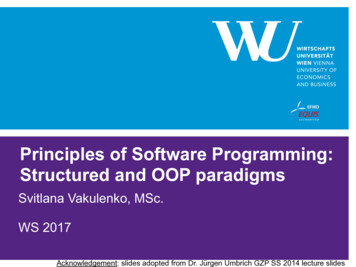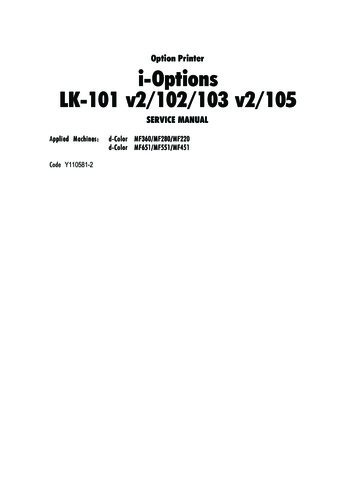
Transcription
CGI PROGRAMMING 101Perl for the World Wide Web2nd Edition 2004 by JACQUELINE D. HAMILTONThe following material is excerpted from “CGI Programming 101” (2nd edition) byJacqueline D. Hamilton. It is copyrighted and may not be redistributed. You may makeone printed copy for your own personal use; any other reproduction or retransmission ofthis document is prohibited.
IntroductionThis book is intended for web designers, entrepreneurs, students, teachers, and anyonewho is interested in learning CGI programming. You do not need any programmingexperience to get started; if you can write HTML, you can write CGI programs. If youhave a website, and want to add guestbook forms, counters, shopping carts, or otherinteractive elements to your site, then this book is for you.What is CGI?“CGI” stands for “Common Gateway Interface.” CGI is one method by which a webserver can obtain data from (or send data to) databases, documents, and other programs,and present that data to viewers via the web. More simply, a CGI is a program intended tobe run on the web. A CGI program can be written in any programming language, but Perlis one of the most popular, and for this book, Perl is the language we’ll be using.Why learn CGI?If you’re going to create web pages, then at some point you’ll want to add a counter, aform to let visitors send you mail or place an order, or something similar. CGI enablesyou to do that and much more. From mail-forms and counter programs, to the mostcomplex database programs that generate entire websites on-the-fly, CGI programsdeliver a broad spectrum of content on the web today.Why use this book?This book will get you up and running in as little as a day, teaching you the basics ofCGI programs, the fundamentals of Perl, and the basics of processing forms and writingsimple programs. Then we’ll move on to advanced topics, such as reading and writingdata files, searching for data in files, writing advanced, multi-part forms like order formsand shopping carts, using randomness to spice up your pages, using server-side includes,cookies, and other useful CGI tricks. Things that you’ve probably thought beyond yourreach, things you thought you had to pay a programmer to do . . . all of these are thingsyou can easily write yourself, and this book will show you how.You can also try it out before buying the book; the first six chapters are available online,free of charge, at http://www.cgi101.com/book/.
iiiWhat do you need to get started?You should already have some experience building web pages and writing HTML. You’llalso need Perl and a web server (such as Apache) that is configured to allow you to runyour own CGI programs.The book is written towards CGI programming on Unix, but you can also set up Apacheand Perl on Mac OS X and Windows. I’ve written several online tutorials that will showyou how to get started:Windows: http://www.cgi101.com/book/connect/windows.htmlHow to set up Apache and Perl; how to configure Apache; where to write yourprograms; differences between CGI programs on Windows and UnixMac OS X: http://www.cgi101.com/book/connect/mac.htmlHow to configure Apache (which you already have installed); where to writeyour programsUnix: http://www.cgi101.com/book/connect/unix.htmlHow to upload programs to your Unix-based server; Unix tutorial; where towrite your programs; Unix permissions.If you need an ISP that offers CGI hosting, visit http://www.cgi101.com/hosting. CGI101offers Unix shell access, CGI programming, a MySQL database, and all of the Perlmodules used in this book. It’s an easy, hassle-free way to get started writing your ownCGI programs.Working CodeAll of the code examples in this book are available on the web athttp://www.cgi101.com/book/. You can download any or all of them from there, but dotry writing the programs yourself first; you’ll learn faster that way.Conventions Used in this BookPerl code will be set apart from the text by indenting and use of a fixed-width font:print "This is a print statement.\n";Unix shell commands are shown in a bold font: chmod 755 filenameEach program in the book is followed by a link to its source code:2 Source code: http://www.cgi101.com/book/chX/program-cgi.htmlIn most cases, a link to a working example is also included:
iv Working example: http://www.cgi101.com/book/chX/demo.htmlEach chapter has its own web page at http://www.cgi101.com/book/chX, where X isthe chapter number. The full text of chapters 1-6 are online; other chapters include anindex of the CGI programs and HTML forms from that chapter, links to online resourcesmentioned in that chapter, questions and answers relating to the chapter material, plus anychapter errata.What’s New In This Edition?The 2nd edition of CGI Programming 101 has been substantially revised from the firstedition. You’ll learn about Perl modules from the beginning, and work with modules(including the CGI.pm module, which offers many great features for writing CGIprograms) throughout the book. You’ll learn how to password protect an area on yourwebsite, how to build an online catalog with a shopping cart, how to work with cookies,how to protect your site from spammers, and much more.So turn to Chapter 1, and let’s get started.
1Getting StartedOur programming language of choice for this book is Perl. Perl is a simple, easy to learnlanguage, yet powerful enough to accomplish very difficult and complex tasks. It iswidely available, and is probably already installed on your Unix server. You don’t need tocompile your Perl programs; you simply write your code, save the file, and run it (or havethe web server run it). The program itself is a simple text file; the Perl interpreter does allthe work. The advantage to this is you can move your program with little or no changesto any machine with a Perl interpreter. The disadvantage is you won’t discover any bugsin your program until you run it.You can write and edit your CGI programs (which are often called scripts) either on yourlocal machine or in the Unix shell. If you’re using Unix, try pico – it’s a very simple, easyto use text editor. Just type pico filename to create or edit a file. Type man pico for moreinformation and help using pico. If you’re not familiar with the Unix shell, see AppendixA for a Unix tutorial and command reference.You can also use a text editor on your local machine and upload the finished programs tothe web server. You should either use a plain text editor, such as Notepad (PC) or BBEdit(Mac), or a programming-specific editor that provides some error- and syntax-checkingfor you. Visit http://www.cgi101.com/book/editors.html for a list of some editors you canuse to write your CGI programs.If you use a text editor, be sure to turn off special characters such as “smartquotes.” CGIfiles must be ordinary text.Once you’ve written your program, you’ll need to upload it to the web server (unlessyou’re using pico and writing it on the server already). You can use any FTP or SCP(secure copy) program to upload your files; a list of some popular FTP and SCP programscan be found at http://www.cgi101.com/book/connect/.
2Chapter OneGetting StartedIt is imperative that you upload your CGI programs as plain text (ASCII) files, and notbinary. If you upload your program as a binary file, it may come across with a lot ofcontrol characters at the end of the lines, and these will cause errors in your program.You can save yourself a lot of time and grief by just uploading everything as text (unlessyou’re uploading pictures – for example, GIFs or JPEGs – or other true binary data).HTML and Perl CGI programs are not binary, they are plain text.Once your program is uploaded to the web server, you’ll want to be sure to move it toyour cgi-bin (or public html directory – wherever your ISP has told you to put yourCGI programs). Then you’ll also need to change the permissions on the file so that it is“executable” (or runnable) by the system. The Unix shell command for this is:chmod 755 filenameThis sets the file permissions so that you can read, write, and execute the file, and allother users (including the webserver) can read and execute it. See Appendix A for a fulldescription of chmod and its options.Most FTP and SCP programs allow you to change file permissions; if you use yourFTP client to do this, you’ll want to be sure that the file is readable and executable byeveryone, and writable only by the owner (you).One final note: Perl code is case-sensitive, as are Unix commands and filenames. Pleasekeep this in mind as you write your first programs, because in Unix “perl” is not the sameas “PERL”.What Is This Unix Shell?It’s a command-line interface to the Unix machine – somewhat like DOS. You have touse a Telnet or SSH (secure shell) program to connect to the shell; seehttp://www.cgi101.com/class/connect.html for a list of some Telnet and SSH programsyou can download. Once you’re logged in, you can use shell commands to move around,change file permissions, edit files, create directories, move files, and much more.If you’re using a Unix system to learn CGI, you may want to stop here and look atAppendix A to familiarize yourself with the various shell commands. Download a Telnetor SSH program and login to your shell account, then try out some of the commands soyou feel comfortable navigating in the shell.Throughout the rest of this book you’ll see Unix shell commands listed in bold to setthem apart from HTML and CGI code. If you’re using a Windows server, you can ignoremost of the shell commands, as they don’t apply.
3Chapter OneGetting StartedBasics of a Perl ProgramYou should already be familiar with HTML, and so you know that certain things arenecessary in the structure of an HTML document, such as the head and body tags,and that other tags like links and images have a certain allowed syntax. Perl is verysimilar; it has a clearly defined syntax, and if you follow those syntax rules, you can writePerl as easily as you do HTML.The first line of your program should look like this:#!/usr/bin/perl -wTThe first part of this line, #!, indicates that this is a script. The next part,/usr/bin/perl, is the location (or path) of the Perl interpreter. If you aren’t sure wherePerl lives on your system, try typing which perl or whereis perl in the shell. If thesystem can find it, it will tell you the full path name to the Perl interpreter. That path iswhat you should put in the above statement. (If you’re using ActivePerl on Windows, thepath should be /perl/bin/perl instead.)The final part contains optional flags for the Perl interpreter. Warnings are enabled by the-w flag. Special user input taint checking is enabled by the -T flag. We’ll go into taintchecks and program security later, but for now it’s good to get in the habit of using bothof these flags in all of your programs.You’ll put the text of your program after the above line.Basics of a CGI ProgramA CGI is simply a program that is called by the webserver, in response to some action bya web visitor. This might be something simple like a page counter, or a complex formhandler. Shopping carts and e-commerce sites are driven by CGI programs. So are adbanners; they keep track of who has seen and clicked on an ad.CGI programs may be written in any programming language; we’re just using Perlbecause it’s fairly easy to learn. If you’re already an expert in some other languageand are just reading to get the basics, here it is: if you’re writing a CGI that’s going togenerate an HTML page, you must include this statement somewhere in the programbefore you print out anything else:print "Content-type: text/html\n\n";
4Chapter OneGetting StartedThis is a content-type header that tells the receiving web browser what sort of data it isabout to receive – in this case, an HTML document. If you forget to include it, or if youprint something else before printing this header, you’ll get an “Internal Server Error”when you try to access the CGI program.Your First CGI ProgramNow let’s try writing a simple CGI program. Enter the following lines into a new file, andname it “first.cgi”. Note that even though the lines appear indented on this page, you donot have to indent them in your file. The first line (#!/usr/bin/perl) should start incolumn 1. The subsequent lines can start in any column.Program 1-1: first.cgiHello World Program#!/usr/bin/perl -wTprint "Content-type: text/html\n\n";print "Hello, world!\n";2 Source code: http://www.cgi101.com/book/ch1/first-cgi.html Working example: http://www.cgi101.com/book/ch1/first.cgiSave (or upload) the file into your web directory, then chmod 755 first.cgi to changethe file permissions (or use your FTP program to change them). You will have to do thisevery time you create a new program; however, if you’re editing an existing program, thepermissions will remain the same and shouldn’t need to be changed again.Now go to your web browser and type the direct URL for your new CGI. For ur actual URL will depend on your ISP. If you have an account on cgi101, your URLis:http://www.cgi101.com/ youruserid/first.cgiYou should see a web page with “Hello, world!” on it. (If it you get a “Page Not Found”error, you have the URL wrong. If you got an “Internal Server Error”, see the “DebuggingYour Programs,” section at the end of this chapter.)Let’s try another example. Start a new file (or if you prefer, edit your existing first.cgi)and add some additional print statements. It’s up to your program to print out all ofthe HTML you want to display in the visitor’s browser, so you’ll have to include print
5Chapter OneGetting Startedstatements for every HTML tag:Program 1-2: second.cgiHello World Program 2#!/usr/bin/perl -wTprint "Content-type: text/html\n\n";print " html head title Hello World /title /head \n";print " body \n";print " h2 Hello, world! /h2 \n";print " /body /html \n";2 Source code: http://www.cgi101.com/book/ch1/second-cgi.html Working example: http://www.cgi101.com/book/ch1/second.cgiSave this file, adjust the file permissions if necessary, and view it in your web browser.This time you should see “Hello, world!” displayed in a H2-size HTML header.Now not only have you learned to write your first CGI program, you’ve also learned yourfirst Perl statement, the print function:print "somestring";This function will write out any string, variable, or combinations thereof to the currentoutput channel. In the case of your CGI program, the current output is being printed tothe visitor’s browser.The \n you printed at the end of each string is the newline character. Newlines are notrequired, but they will make your program’s output easier to read.You can write multiple lines of text without using multiple print statements by using thehere-document syntax:print EndMarker;line1line2line3etc.EndMarkerYou can use any word or phrase for the end marker (you’ll see an example next wherewe use “EndOfHTML” as the marker); just be sure that the closing marker matches theopening marker exactly (it is case-sensitive), and also that the closing marker is on a lineby itself, with no spaces before or after the marker.
6Chapter OneGetting StartedLet’s try it in a CGI program:Program 1-3: third.cgiHello World Program, with here-doc#!/usr/bin/perl -wTprint "Content-type: text/html\n\n";print EndOfHTML; html head title Test Page /title /head body h2 Hello, world! /h2 /body /html EndOfHTML2 Source code: http://www.cgi101.com/book/ch1/third-cgi.html Working example: http://www.cgi101.com/book/ch1/third.cgiWhen a closing here-document marker is on the last line of the file, be sure you have aline break after the marker. If the end-of-file mark is on the same line as the here-docmarker, you’ll get an error when you run your program.The CGI.pm ModulePerl offers a powerful feature to programmers: add-on modules. These are collections ofpre-written code that can you can use to do all kinds of tasks. You can save yourself thetime and trouble of reinventing the wheel by using these modules.Some modules are included as part of the Perl distribution; these are called standardlibrary modules and don’t have to be installed. If you have Perl, you already have thestandard library modules.There are also many other modules available that are not part of the standard library.These are typically listed on the Comprehensive Perl Archive Network (CPAN), whichyou can search on the web at http://search.cpan.org.The CGI.pm module is part of the standard library, and has been since Perl version5.004. (It should already be installed; if it’s not, you either have a very old or very brokenversion of Perl.) CGI.pm has a number of useful functions and features for writing CGIprograms, and its use is preferred by the Perl community. We’ll be using it frequentlythroughout the book.Let’s see how to use a module in your CGI program. First you have to actually include
7Chapter OneGetting Startedthe module via the use command. This goes after the #!/usr/bin/perl line and beforeany other code:use CGI qw(:standard);Note we’re not doing use CGI.pm but rather use CGI. The .pm is implied in theuse statement. The qw(:standard) part of this line indicates that we’re importing the“standard” set of functions from CGI.pm.Now you can call the various module functions by typing the function name followed byany arguments:functionname(arguments)If you aren’t passing any arguments to the function, you can omit the parentheses.A function is a piece of code that performs a specific task; it may also be calleda subroutine or a method. Functions may accept optional arguments (also calledparameters), which are values (strings, numbers, and other variables) passed into thefunction for it to use. The CGI.pm module has many functions; for now we’ll start byusing these three:header;start html;end html;The header function prints out the “Content-type” header. With no arguments, the typeis assumed to be “text/html”. start html prints out the html , head , title and body tags. It also accepts optional arguments. If you call start html with only asingle string argument, it’s assumed to be the page title. For example:print start html("Hello World");will print out the following*: html head title Hello World /title head body * Actually start html prints out a full XML header, complete with XML and DOCTYPE tags.In other words, it creates a proper HTML header for your page.
8Chapter OneGetting StartedYou can also set the page colors and background image with start html:print start html(-title "Hello World",-bgcolor "#cccccc", -text "#999999",-background "bgimage.jpg");Notice that with multiple arguments, you have to specify the name of each argument with-title , -bgcolor , etc. This example generates the same HTML as above, onlythe body tag indicates the page colors and background image: body bgcolor "#cccccc" text "#999999"background "bgimg.jpg" The end html function prints out the closing HTML tags: /body /html The Other Way To Use CGI.pmor “There’s More Than One Way To Do Things In Perl”As you learn Perl you’ll discover there are often many different ways to accomplishthe same task. CGI.pm exemplifies this; it can be used in two different ways. Thefirst way you’ve learned already: function-oriented style. Here you must specifyqw(:standard) in the use line, but thereafter you can just call the functionsdirectly:use CGI qw(:standard);print header;print start html("Hello World");The other way is object-oriented style, where you create an object (or instance of themodule) and use that to call the various functions of CGI.pm:use CGI;# don't need qw(:standard) cgi CGI- new;# ( cgi is now the object)print cgi- header;# function call: obj- functionprint cgi- start html("Hello World");Which style you use is up to you. The examples in this book use the functionoriented style, but feel free to use whichever style you’re comfortable with.
9Chapter OneGetting StartedSo, as you can see, using CGI.pm in your CGI programs will save you some typing. (Italso has more important uses, which we’ll get into later on.)Let’s try using CGI.pm in an actual program now. Start a new file and enter these lines:Program 1-4: fourth.cgiHello World Program, using CGI.pm#!/usr/bin/perl -wTuse CGI qw(:standard);print header;print start html("Hello World");print " h2 Hello, world! /h2 \n";print end html;2 Source code: http://www.cgi101.com/book/ch1/fourth-cgi.html Working example: http://www.cgi101.com/book/ch1/fourth.cgiBe sure to change the file permissions (chmod 755 fourth.cgi), then test it out in yourbrowser.CGI.pm also has a number of functions that serve as HTML shortcuts. For instance:print h2("Hello, world!");Will print an H2-sized header tag. You can find a list of all the CGI.pm functions bytyping perldoc CGI in the shell, or visiting http://www.perldoc.com/ and entering“CGI.pm” in the search box.Documenting Your ProgramsDocumentation can be embedded in a program using comments. A comment in Perl ispreceded by the # sign; anything appearing after the # is a comment:Program 1-5: fifth.cgiHello World Program, with Comments#!/usr/bin/perl -wTuse CGI qw(:standard);# This is a comment# So is this## Comments are useful for telling the reader# what's happening. This is important if you
10Chapter OneGetting Started# write code that someone else will have to# maintain later.print header;# here's a comment. print the headerprint start html("Hello World");print " h2 Hello, world! /h2 \n";print end html; # print the footer# the end.2 Source code: http://www.cgi101.com/book/ch1/fifth-cgi.html Working example: http://www.cgi101.com/book/ch1/fifth.cgiYou’ll notice the first line (#!/usr/bin/perl) is a comment, but it’s a special kind ofcomment. On Unix, it indicates what program to use to run the rest of the script.There are several situations in Perl where an #-sign is not treated as a comment. Thesedepend on specific syntax, and we’ll look at them later in the book.Any line that starts with an #-sign is a comment, and you can also put comments at theend of a line of Perl code (as we did in the above example on the header and end htmllines). Even though comments will only be seen by someone reading the source code ofyour program, it’s a good idea to add comments to your code explaining what’s going on.Well-documented programs are much easier to understand and maintain than programswith no documentation.Debugging Your ProgramsA number of problems can happen with your CGI programs, and unfortunately the defaultresponse of the webserver when it encounters an error (the “Internal Server Error”) is notvery useful for figuring out what happened.If you see the code for the actual Perl program instead of the desired output page fromyour program, this probably means that your web server isn’t properly configured to runCGI programs. You’ll need to ask your webmaster how to run CGI programs on yourserver. And if you ARE the webmaster, check your server’s documentation to see how toenable CGI programs.If you get an Internal Server Error, there’s either a permissions problem with the file (didyou remember to chmod 755 the file?) or a bug in your program. A good first step indebugging is to use the CGI::Carp module in your program:use CGI::Carp qw(warningsToBrowser fatalsToBrowser);
11Chapter OneGetting StartedThis causes all warnings and fatal error messages to be echoed in your browser window.You’ll want to remove this line after you’re finished developing and debugging yourprograms, because Carp errors can give away important security info to potential hackers.If you’re using the Carp module and are still seeing the “Internal Server Error”, you canfurther test your program from the command line in the Unix shell. This will check thesyntax of your program without actually running it:perl -cwT fourth.cgiIf there are errors, it will report any syntax errors in your program:% perl -cwT fourth.cgisyntax error at fourth.cgi line 5, near “print”fourth.cgi had compilation errors.This tells you there’s a problem on or around line 5; make sure you didn’t forget a closingsemicolon on the previous line, and check for any other typos. Also be sure you savedand uploaded the file as text; hidden control characters or smartquotes can cause syntaxerrors, too.Another way to get more info about the error is to look at the webserver log files. Usuallythis will show you the same information that the CGI::Carp module does, but it’s good toknow where the server logs are located, and how to look at them. Some usual locationsare /usr/local/etc/httpd/logs/error log, or /var/log/httpd/error log. Ask your ISP if youaren’t sure of the location. In the Unix shell, you can use the tail command to view theend of the log file:tail /var/log/apache/error logThe last line of the file should be your error message (although if you’re using a sharedwebserver like an ISP, there will be other users’ errors in the file as well). Here are someexample errors from the error log:[Fri Jan 16 02:06:10 2004] access to /home/book/ch1/test.cgi failed for205.188.198.46, reason: malformed header from script.In string, @yahoo now must be written as \@yahoo at /home/book/ch1/test.cgi line331, near “@yahoo”Execution of /home/book/ch1/test.cgi aborted due to compilation errors.[Fri Jan 16 10:04:31 2004] access to /home/book/ch1/test.cgi failed for204.87.75.235, reason: Premature end of script headersA “malformed header” or “premature end of script headers” can either mean that you
12Chapter OneGetting Startedprinted something before printing the “Content-type: text/html” line, or your programdied. An error usually appears in the log indicating where the program died, as well.ResourcesThe CGI.pm module: http://stein.cshl.org/WWW/software/CGI/The Official Guide to Programming with CGI.pm, by Lincoln SteinVisit http://www.cgi101.com/book/ch1/ for source code and links from this chapter.
2Perl VariablesBefore you can proceed much further with CGI programming, you’ll need someunderstanding of Perl variables and data types. A variable is a place to store a value,so you can refer to it or manipulate it throughout your program. Perl has three types ofvariables: scalars, arrays, and hashes.ScalarsA scalar variable stores a single (scalar) value. Perl scalar names are prefixed with adollar sign ( ), so for example, x, y, z, username, and url are all examples of scalarvariable names. Here’s how variables are set: foo 1; name "Fred"; pi 3.141592;In this example foo, name, and pi are scalars. You do not have to declare a variablebefore using it, but its considered good programming style to do so. There are severaldifferent ways to declare variables, but the most common way is with the my function:my foo 1;my ( name) "Fred";my ( pi) 3.141592;my simultaneously declares the variables and limits their scope (the area of code that cansee these variables) to the enclosing code block. (We’ll talk more about scope later.) Youcan declare a variable without giving it a value:my foo;
14Chapter TwoPerl VariablesYou can also declare several variables with the same my statement:my ( foo, bar, blee);You can omit the parentheses if you are declaring a single variable, however a list ofvariables must be enclosed in parentheses.A scalar can hold data of any type, be it a string, a number, or whatnot. You can also usescalars in double-quoted strings:my fnord 23;my blee "The magic number is fnord.";Now if you print blee, you will get “The magic number is 23.” Perl interpolates thevariables in the string, replacing the variable name with the value of that variable.Let’s try it out in a CGI program. Start a new program called scalar.cgi:Program 2-1: scalar.cgiPrint Scalar Variables Program#!/usr/bin/perl -wTuse CGI qw(:standard);use CGI::Carp qw(warningsToBrowser fatalsToBrowser);use strict;my email "fnord\@cgi101.com";my url "http://www.cgi101.com";print header;print start html("Scalars");print EndHTML; h2 Hello /h2 p My e-mail address is email, and my web url is a href " url" url /a . /p EndHTMLprint end html;2 Source code: http://www.cgi101.com/book/ch2/scalar-cgi.html Working example: http://www.cgi101.com/book/ch2/scalar.cgi
15Chapter TwoPerl VariablesYou may change the email and url variables to show your own e-mail address* andwebsite URL. Save the program, chmod 755 scalar.cgi, and test it in your browser.You’ll notice a few new things in this program. First, there’s use strict. This is astandard Perl module that requires you to declare all variables. You don’t have to use thestrict module, but it’s considered good programming style, so it’s good to get in thehabit of using it.You’ll also notice the variable declarations:my email "fnord\@cgi101.com";my url "http://www.cgi101.com";Notice that the @-sign in the e-mail address is escaped with (preceded by) a backslash.This is because the @-sign means something special to Perl – just as the dollar signindicates a scalar variable, the @-sign indicates an array, so if you want to actually usespecial characters like @, , and % inside a double-quoted string, you have to precedethem with a backslash (\).A better way to do this would be to use a single-quoted string for the e-mail address:my email 'fnord@cgi101.com';Single-quoted strings are not interpolated the way double-quoted strings are, so you canfreely use the special characters , @ and % in them. However this also means you can’tuse a single-quoted string to print out a variable, becauseprint ' fnord';will print the actual string “ fnord” . . . not the value stored in the variable named fnord.ArraysAn array stores an ordered list of values. While a scalar variable can only store onevalue, an array can store many. Perl array names are prefixed with an @-sign. Here is anexample:* You should try to avoid leaving your e-mail address permanently displayed on your web site.Spammers routinely crawl the web looking for e-mail addresse
HTML and Perl CGI programs are not binary, they are plain text. Once your program is uploaded to the web server, you’ll want to be sure to move it to your cgi-bin (or public_html directory – wherever your ISP has told you to put your CGI programs). Then you’ll also










